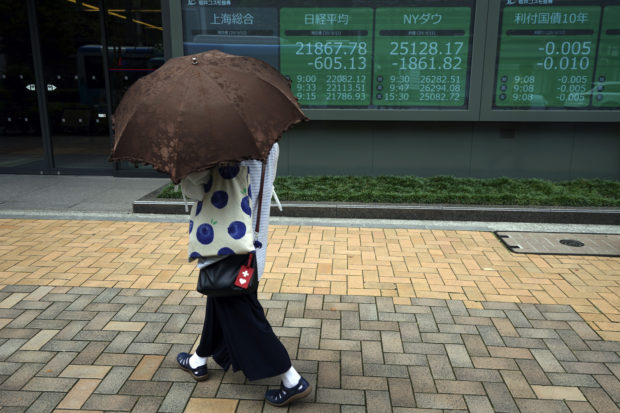Asian shares were moderately lower Friday after an overnight rout on Wall Street as investors were spooked by reports of rising coronavirus cases in the U.S.

A woman walks past an electronic stock board showing Japan’s Nikkei 225 index and New York Dow index at a securities firm in Tokyo Friday, June 12, 2020. Asian shares were moderately lower Friday after an overnight rout on Wall Street as investors were spooked by reports of rising coronavirus cases in the U.S. (AP Photo/Eugene Hoshiko)
Fear that a so-called “second wave,” is already coming has punctured bubbling optimism that a quick economic recovery was already underway. That pushed the Dow Jones Industrial Average down almost 7% on Thursday.
However, Wall Street futures pointed to a steady open on Friday, with the contract for the S&P 500 up 1% and that for the Dow industrials up 1.1%.
Japan’s benchmark Nikkei 225 dipped by 2.2% but was trading 1.5% lower at 22,131.14 by midmorning.
South Korea’s Kospi lost 2.5% to 2,122.62. Australia’s S&P/ASX 200 skidded 1.8% to 5,851.90. Hong Kong’s Hang Seng shed 1.2% to 24,195.52, while the Shanghai Composite dipped 0.7% to 2,899.16.
Losses were milder in Asia than in the U.S. partly because markets in the region have not seen massive gains in recent weeks: outbreaks of the virus, travel disruptions and business shutdowns remain apparent and hopes for a quick rebound more modest.
Although daily newly confirmed cases in Japan have fallen to double-digit levels, workers are returning to work and stores are reopening, without a strong U.S. recovery there are scant expectations for an escape from recession, analysts say.
“It appears that worries about ‘second wave’ of infections have hit, with a swell in the number of cases in states like Arizona and Texas giving cause for concern,” said Riki Ogawa at Mizuho Bank’s Asia and Oceania Treasury Department, noting U.S. Treasury Secretary Steven Mnuchin has said the U.S. can’t afford another lockdown.
“Reports of positive cases from the global protest marches are probably also unearthing fears that a ‘second wave’ may squander the costly curve flattening efforts taken earlier,” Ogawa said.
The Dow Jones Industrial Average sank 6.9%, or 1,861.82 points, to 25,128.17. The S&P 500 dropped 5.9% to 3,002.10, its worst day since mid-March when stocks went through repeated harrowing falls as the virus lockdowns began.
The Nasdaq composite, which rose above 10,000 for the first time a day earlier, lost 527.62 points, or 5.3%, to 9,492.73.
The S&P 500 rallied 44.5% between late March and Monday, erasing most of its losses tied to the pandemic. Skeptics have been saying the rally was overdone.
As businesses reopen and people emerge from stay-at-home orders, cases are climbing in nearly half the states, according to an Associated Press analysis.
“Not surprisingly, a lack of preventative behavior has led to a resurgence in COVID-19 cases around the country, and the stock market is having another gut check,” said Chris Zaccarelli, chief investment officer for Independent Advisor Alliance.
Investor optimism for a speedy recovery was also dimmed by the Federal Reserve, which warned Wednesday that the road to recovery from the worst downturn in decades would be long and vowed to keep rates low for the foreseeable future.
It estimated that the economy will shrink 6.5% this year, in line with other forecasts, before expanding 5% in 2021. It also expects the unemployment rate at 9.3%, near the peak of the last recession, by the end of this year. It’s now 13.3%.
Those factors, along with the recent run-up in stock prices, set the stage for the wave of selling Thursday.
Small company stocks are bearing the brunt of the selling, a signal that investors are becoming more pessimistic about a broad recovery in the economy. The Russell 2000 index fell 111.17 points, or 7.6%, to 1,356.22. European and Asian markets also fell.
Bond yields also fell, a sign of increasing caution among investors who shifted more money into government bonds.
The yield on the 10-year Treasury was at 0.68% Friday after sliding to 0.66% from 0.74% late Wednesday, a big move. Last Friday it briefly rose above 0.90%. It started the year at 1.92%.
Emergency rescue efforts by the Fed and Congress helped arrest the market’s staggering 34% skid in February and March.
Investors are still waiting for more data to see whether surges spike in COVID-19 cases signal a possible second wave of the infections, said Charlie Ripley, senior investment strategist for Allianz Investment Management.
“We think the recovery is largely underway, but there is still some considerable uncertainty on the path we have ahead,” Ripley said.
The Labor Department said Thursday that about 1.5 million people applied for U.S. unemployment benefits last week, another sign that many Americans are still losing their jobs even as the economy begins to gradually reopen.
The latest figure marked the 10th straight weekly decline in applications for jobless aid since they peaked in mid-March when the coronavirus hit hard. Still, the pace of layoffs remains historically high.
In other trading, benchmark U.S. crude oil fell $1.32 to $35.02 a barrel in electronic trading on the New York Mercantile Exchange. It fell $3.26 to settle at $36.34 a barrel Thursday. Brent crude oil fell $1.07 to $37.48 a barrel.
The dollar was almost unchanged at 106.86 Japanese yen. The euro rose to $1.1296 from $1.1294.